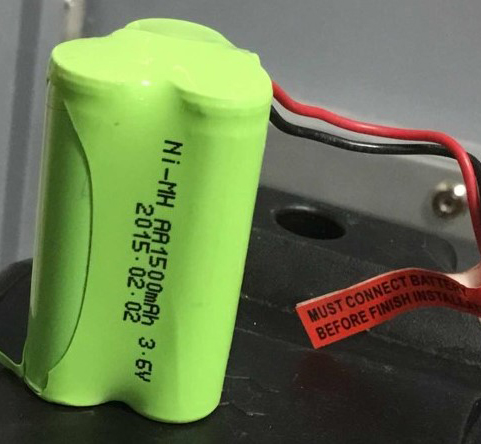Batteries: Understanding the Difference Between Ni-Cad and Ni-MH Batteries
For the past couple of decades, the industry has relied on two main secondary power sources for Exits Signs and Emergency Lights. They are the Sealed Lead Acid and Sealed Nickel Cadmium (Ni-Cad). Recently, a number of the major Emergency Lighting Companies have introduced units with Lithium Iron Phosphate batteries and Nickel Metal Hydrate batteries. It appears that this is the direction the industry is going.
Caution
When you purchase batteries from Brooks, it is important to understand that there is a difference between Ni-Cad and Ni-MH batteries and to request the correct battery for quotes, pricing, and ordering. The reason is, in most cases, they look identical. Here is an example of two AA 3.6 Volt battery packs.
 Nickel Cadmium (Ni-Cad)
Nickel Cadmium (Ni-Cad)
 Nickel Metal Hydrate (Ni-MH)
Nickel Metal Hydrate (Ni-MH)
As you can see, these batteries look identical, but they are not. The first picture is of a Nickel Cadmium (Ni-Cad) battery, while the second picture is of a Nickel Metal Hydrate (Ni-MH) battery. You should never use one in place of the other in an Emergency Light or Exit Sign—you must stay with the given chemistry of the unit. In this case, both batteries are 3.6 Volts, but what you have to be concerned about is the unit’s charging circuit, especially how it determines end of charge. Plus, you do not know how the manufacturer has designed the unit to charge the batteries. If batteries are improperly charged, there is a risk of overheating, venting gases, and even having a battery explode. Bottom line—stay true to the unit’s original battery chemistry.
Ni-MH batteries are specific to the manufacturer of the Emergency Light or Exit Sign and substitutes can not be made. It is important to not only get the battery information (and a picture of it, if possible), but also get the Manufacturer’s name and model number of the unit. This will help ensure that the proper battery is being installed.
Remember, too, Ni-Cad, Ni-MH, and LiFePO4 batteries can be safely recycled together in Brooks New Ni-Cad Recycling Buckets. Learn more about Brooks Recycling Program.
Click Here
to view a PDF version
© 2021 Brooks Equipment.
Disclaimer: The opinions expressed in the above Tech Series
article are the author’s only and provide limited information.
Although the information is believed to be reliable, Brooks
Equipment Company, LLC expressly disclaims any warranty with
respect to the information and any liability for errors or
omissions. The user of this article or the product(s) is
responsible for verifying the information’s accuracy from all
available sources, including the product manufacturer. The
authority having jurisdiction should be contacted for
code interpretations.